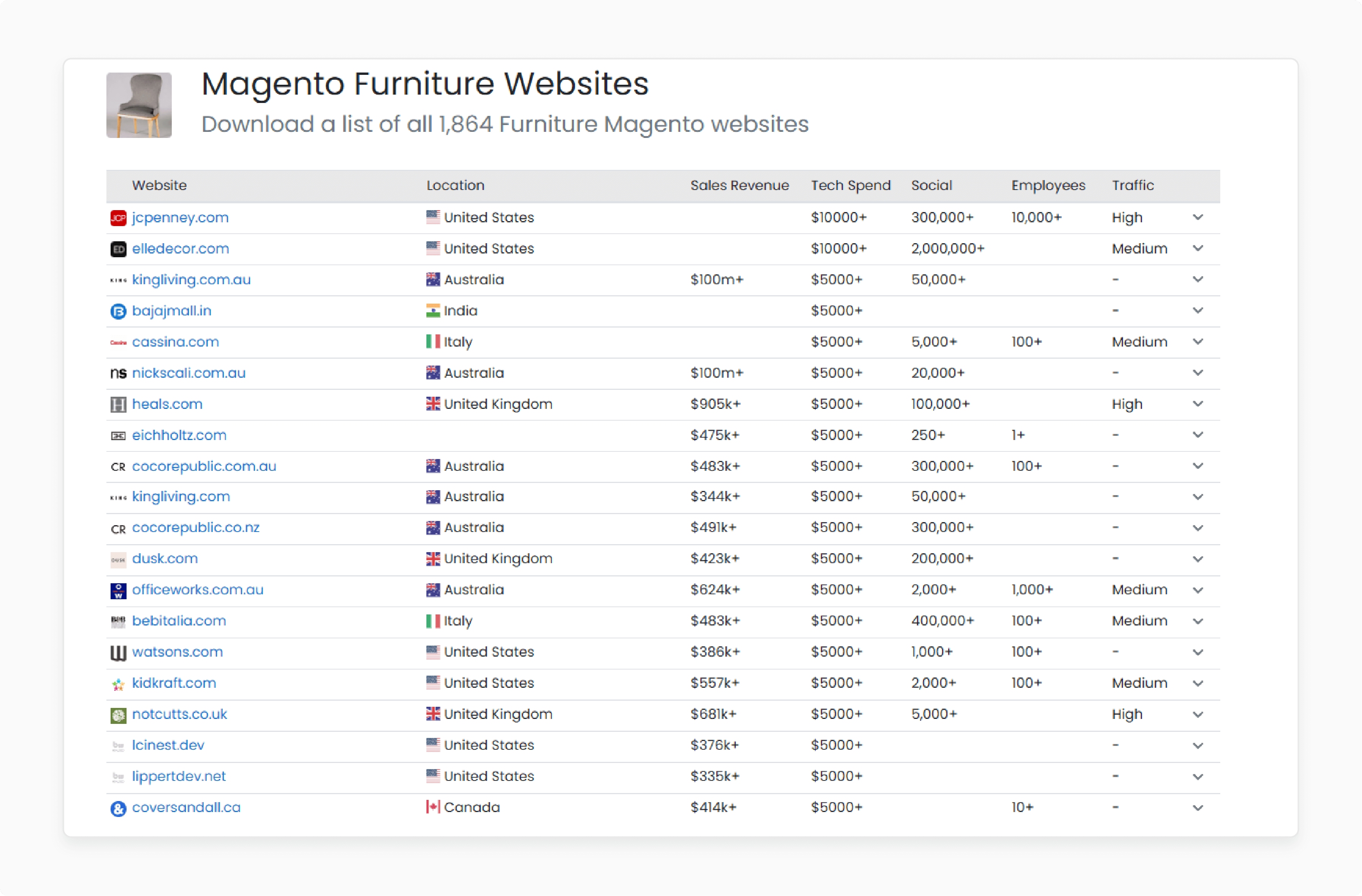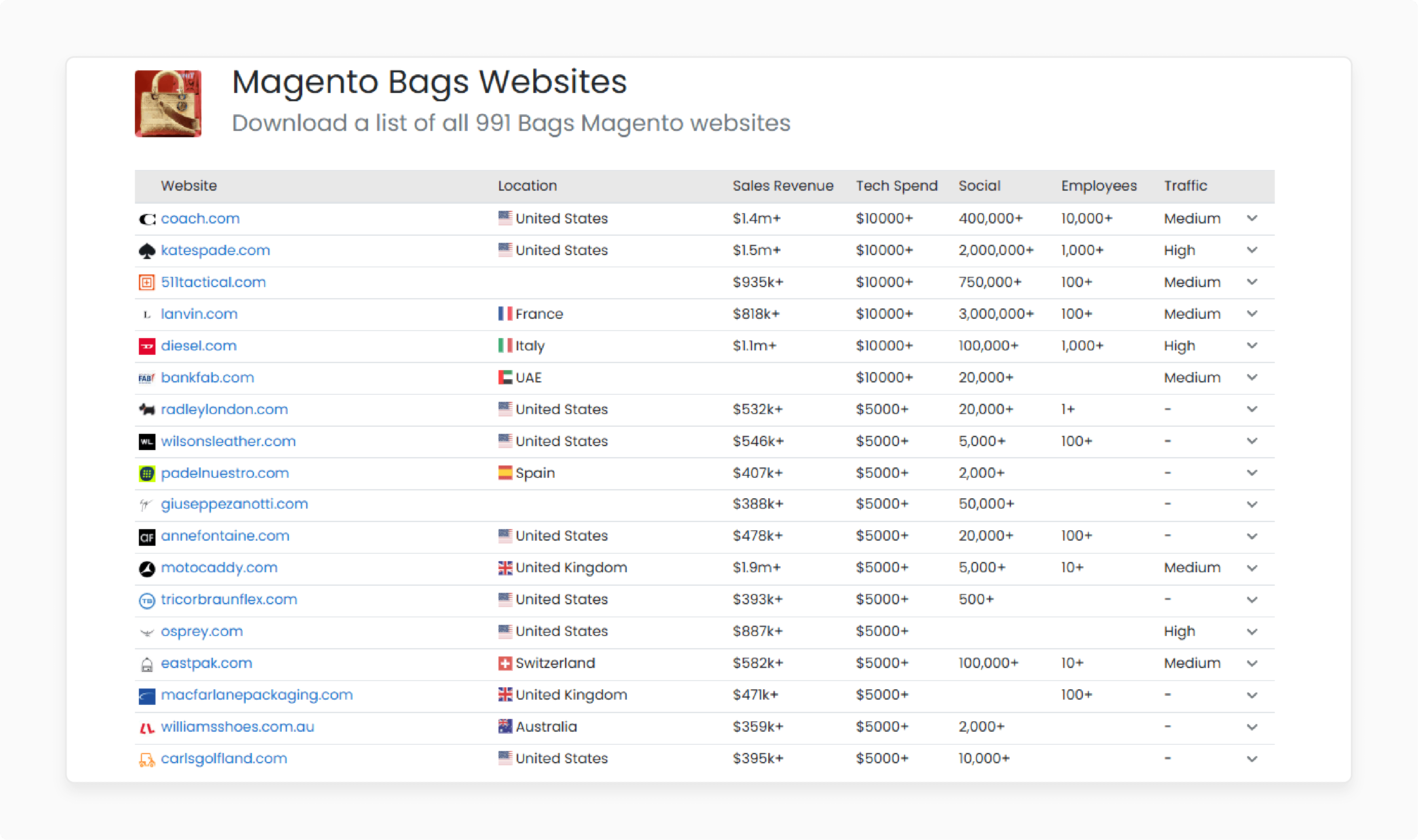
Magento Market Share Statistics Q4 2024: Detailed Report
Curious about Magento’s position in the worldwide e-commerce platform market?
Q4 2024 Magento market share statistics reveal huge global usage and growth. The platform powers over 239,000 websites as of 2024. It maintains its position in the top 3 most used ecommerce solutions globally.
The present article explores its adoption trends, regional dominance, and industry impact.
Key Takeaways
-
Magento stands amongst the top 3 ecommerce solutions worldwide.
-
Magento’s market share ranks high among e-commerce platforms.
-
Magento supports complex integrations for global businesses.
-
Mobile optimization drives 46% of traffic for Magento stores.
-
European markets show strong adoption of Magento stores.
-
Magento vs. Shopify vs. Woocomerce Live Site Usage Statistics
-
Magento vs. Shopify vs. WooCommerce: Top 10 Countries' Distribution
Historical Growth Trend of Magento (2007-2024)
1. Foundation Phase (2007-2010)
Roy Rubin and Yoav Kutner launched Magento in 2007. By 2008, the platform had reached 500,000 downloads. Magento Open Source version 1.0 marked early success. The e-commerce platform gained popularity through customization options.
2. Expansion Phase (2011-2015)
eBay invested in Magento in February 2011. Downloads reached 4 million by February 2012. The platform released Magento Enterprise Edition. Developers started working on Magento 2. Payment integration improved through the PayPal partnership.
3. Market Leadership (2016-2018)
Magento-based stores sold $101 billion in 2016. Gartner named Magento as the digital commerce leader. Magento Commerce Cloud represented 40% of bookings. Forrester recognized Magento's B2B leadership. Adobe acquired Magento for $1.68 billion.
4. Adobe Integration (2019-2022)
Adobe Experience Cloud incorporated Magento Commerce Cloud. The platform enhanced security through AWS storage. Adobe improved development tools and features. Mobile responsiveness became a priority. Performance upgrades increased site speeds.
5. Current Growth (2023-2024)
Magento powers 239,000 websites worldwide (live and demo sites included). The platform shows 300% growth over six years1. Magento handles $155 billion in yearly transactions. 12,881 top million websites use Magento1. Market share reaches 27.8% in the e-commerce segment.
Magento vs. Shopify vs. Woocomerce Live Site Usage Statistics
| Metric | Magento | Shopify | WooCommerce |
|---|---|---|---|
| Total Live Sites | 116,227 | 4,949,244 | 6,025,992 |
| Additional Redirects | 368,698 | 1,651,998 | 2,625,394 |
| Live and Historical | 665,033 | 8,843,857 | 14,922,132 |
| Top 1m Sites | 9,498 (0.95%) | 29,306 (2.93%) | 32,425 (3.24%) |
| Top 100k Sites | 1,115 (1.12%) | 3,138 (3.14%) | 2,873 (2.87%) |
| Top 10k Sites | 109 (1.09%) | 344 (3.44%) | 236 (2.36%) |
Magento vs. Shopify vs. WooCommerce: Top 10 Countries' Distribution
| Country | Magento (live sites, % from total Magento live sites) | Shopify (live sites, % from total Shopify live sites) | WooCommerce (live sites, % from total WooCommerce live sites) |
|---|---|---|---|
| United States | 39,541 (34.04%) | 2,856,231 (57.66%) | 2,480,339 (41.17%) |
| United Kingdom | 9,097 (7.83%) | 194,553 (3.93%) | 233,505 (3.88%) |
| Netherlands | 8,080 (6.95%) | 56,460 (1.14%) | 131,170 (2.18%) |
| Germany | 7,319 (6.30%) | 125,490 (2.54%) | 165,657 (2.75%) |
| Italy | 3,849 (3.31%) | 43,823 (0.89%) | 138,084 (2.29%) |
| Brazil | 3,573 (3.07%) | 118,789 (2.40%) | 147,652 (2.45%) |
| France | 3,487 (3.00%) | 72,894 (1.47%) | 153,204 (2.54%) |
| Australia | 3,314 (2.85%) | 142,382 (2.88%) | 119,558 (1.98%) |
| Spain | 2,843 (2.45%) | 25,727 (0.52%) | 118,238 (1.96%) |
| India | 1,848 (1.59%) | 78,411 (1.58%) | 186,828 (3.10%) |
Key Observations (based on country-wise distribution from the total number of individual live sites):
-
Netherlands shows a strong Magento market share at 6.95%, compared to Shopify (1.14%) and WooCommerce (2.18%).
-
The magento platform maintains higher market penetration in European markets. Italy shows Magento holds 3.31%, while Shopify holds 0.89%. Spain, on the other hand, shows Magento at 2.45% vs Shopify holding 0.52%
-
The United Kingdom reveals Magento's strength with a 7.83% market share, doubling Shopify's 3.93%.
-
German e-commerce platform usage favors Magento at 6.30%, surpassing both competitors' percentages.
Top Ecommerce Categories on Magento Based on Live Sites
1. Furniture Market Leadership

-
1,864 furniture stores operate on Magento. The platform's 3D viewing capabilities enhance customer confidence.
-
Large inventory management meets bulk order needs. The platform handles complex pricing and shipping calculations.
-
Custom attributes support detailed product specifications. Multiple warehouse locations integrate smoothly.
-
High-resolution image support drives sales conversion. Product configurators allow real-time customization.
2. Fashion Industry Dominance

-
1,558 fashion retailers use Magento's features. Quick updates keep inventory current and trending.
-
Color and size variants display efficiently. Advanced filtering helps customers find exact matches.
-
The mobile-first design captures younger audiences. Social media integration boosts brand visibility.
-
Multiple currency support enables global sales. Local payment methods increase conversion rates.
3. Footwear Sector Growth

-
1,193 shoe stores thrive on Magento. Stock management prevents overselling popular sizes.
-
Cross-selling features boost accessory sales. Size guides help reduce return rates.
-
Multiple warehouse integration speeds delivery. Real-time inventory updates prevent stockouts.
-
Customer reviews build shopping confidence. Size recommendation tools improve fit accuracy.
4. Grocery and Food Evolution

-
1,147 food retailers rely on Magento. Perishable items require precise stock control.
-
Multiple delivery options serve diverse needs. Same-day delivery scheduling increases satisfaction.
-
Subscription models support regular purchases. Fresh food categories need special handling.
-
Temperature-zone-based shipping rules work automatically. Local store pickup options increase flexibility.
5. Bags and Accessories Specialization

-
991 bag retailers have brimming Magento stores. High-quality zoom functions display craftsmanship.
-
Category-specific filters streamline the shopping experience. Style matching suggestions increase cart value.
-
Brand storytelling features engage customers. Material care instructions build trust.
-
Warranty information is displayed prominently. Return policies adapt to product categories.
5 Unique Facts About Magento Platform Usage Ranking
1. Global Website Rankings
Magento ranks 9th among open-source platforms across the entire internet. The platform's customization options and scalability drive its worldwide adoption. Adobe Commerce integration strengthens its position in enterprise-level solutions.
2. Top Website Performance
Magento is fourth among the top one million sites. Large enterprises choose it for complex e-commerce requirements. The platform excels at handling high-traffic websites with multiple storefronts.
3. Regional Market Leaders
Magento ranks 4th in Kuwait and New Caledonia's open-source category. Middle Eastern merchants value Magento's multi-language and currency features. Pacific region businesses benefit from its strong B2B capabilities.
4. European Stronghold
The platform ranks 5th in the Netherlands and Finland. European merchants appreciate Magento's GDPR compliance features. The strong developer community in Europe supports local implementations.
5. Asia-Pacific Presence
Magento stands 7th in India and 5th in Australia. The platform's flexible pricing models suit diverse market needs. Local payment gateway integrations boost regional merchant adoption.
FAQs
1. How many websites use Magento in 2024?
As of 2024, Magento powers over 239,000 websites, including both Magento sites and demo versions. Magento 2 has significantly boosted the number of Magento stores and continues to show growth in its usage statistics. Magento platforms are used widely across industries, showing a solid presence in the ecommerce market.
2. What is Magento's market share in 2024?
Magento’s market share in 2024 reached 2.34% in the global e-commerce market. Magento holds a significant share among the top 1 million sites. Its growth statistics reflect how it competes against platforms like Shopify and WooCommerce, establishing Magento as one of the leading ecommerce platforms.
3. How does Magento compare to other ecommerce platforms?
Magento ranks highly among popular ecommerce platforms, especially compared to Shopify and WooCommerce. Magento’s market share stands strong with its Magento community edition, which supports a vast number of Magento users globally. As a PHP-based ecommerce platform, Magento is the choice for those seeking scalability and customizability.
4. What industries benefit from using Magento?
Magento is widely used across multiple industries, including top categories for Magento stores such as fashion, furniture, and food retail. Magento stores cater to these categories by offering features like inventory management, mobile responsiveness, and multi-currency support, which are key for Magento customers.
5. How does Magento perform in Europe?
In Europe, Magento holds a substantial market share. Countries like the Netherlands and Germany see Magento platform usage outpacing competitors. Magento in Europe benefits from its strong Magento ecosystem, which supports complex customizations and integrations for Magento 1 and Magento 2 stores.
6. What are the growth statistics for Magento in 2024?
Magento’s growth statistics show an impressive 300% growth over six years, driven by the adoption of Magento 2. Magento websites now process over $155 billion annually. The Magento community continues to expand, contributing to its e-commerce market share in 2024.
7. Why is Magento considered one of the leading ecommerce platforms?
Magento has become a leading ecommerce platform due to its advanced features, including custom product configurations and mobile optimization. With a strong presence in industries like fashion and furniture, Magento 2 offers better performance, making it a go-to for businesses requiring scalability.
Summary
Exploring Q4 2024 Magento market share statistics revealed unique adoption trends. Country-wise adoption rates were much higher than open-source. Below listed are the key statistics highlights from the article:
-
Magento powers 116,227 active online stores worldwide. Its market share focuses on mid to large-sized businesses that need complex e-commerce solutions.
-
The furniture sector leads with 1,864 stores on Magento. Custom product configurations and high-resolution imaging drive this category's success.
-
Adobe Commerce's acquisition significantly changed Magento's market position. The platform now targets enterprise clients rather than small businesses.
-
European markets show strong Magento adoption rates. The Netherlands and Finland rank it 5th among open-source platforms.
-
Mobile commerce drives 46% of Magento store traffic. The platform's responsive design supports growing mobile shopping trends.
-
Magento holds 0.6% of the total CMS market share. Yet it maintains higher rankings in the top 1 million websites segment.
Consider managed Magento hosting for enterprise-grade ecommerce performance.






